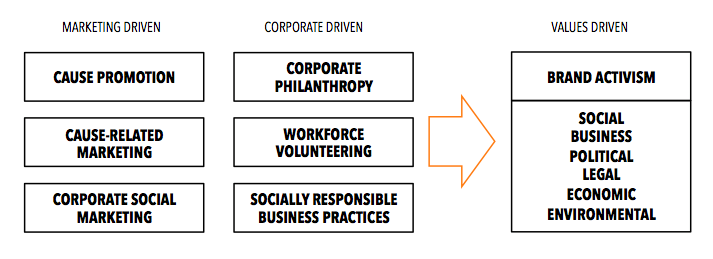
Brand activism is an increasingly popular corporate practice in which companies voluntarily take a stance on what they think is “good” for society and then make corresponding public statements and, occasionally, adapt their operations in ways that support their chosen social causes. Unlike corporate social responsibility efforts (which focus on making a company’s core operations more sustainable or ethically-minded), brand activism often tackles societal, environmental, or human issues that are not directly associated with the company’s core product or operations.
So what is brand activism? Wikipedia describes activism as:
“Activism consists of efforts to promote, impede, or direct social, political, economic, and/or environmental reform or stasis with the desire to make improvements in society. Forms of activism range from writing letters to newspapers or to politicians, political campaigning, economic activism such as boycotts or preferentially patronizing businesses, rallies, street marches, strikes, sit-ins, and hunger strikes.”
Using this definition as a starting point, Christian Sarkar and Phil Kotler have defined “brand activism” as a natural evolution from corporate social responsibility with businesses moving from corporate-driven operations to models driven by values (see Figure 1). This shift is powered by the fact that the world we live in is increasingly defined by seismic political changes, economic uncertainty, and social angst – a combination of factors that has led consumers to prefer to buy and want to associate themselves with brands they believe stand for a greater purpose and share their values.
Fig. 1: Brand activism as a value-driven business strategy

So, which domains or categories come under the umbrella of brand activism?
We can embrace the different aspects of brand activism by breaking them down as follows:
- Social activism such as equality – gender, LGBT, race, age, etc. –, education, school funding, etc.
- Legal activism dealing with the laws and policies that impact companies, such as tax, workplace, and employment laws.
- Business activism around governance – corporate organization, CEO pay, worker compensation, labor and union relations, etc.
- Economic activism including minimum wage and tax policies that impact income inequality and the redistribution of wealth.
- Political activism covering lobbying, voting, voting rights, and policy (gerrymandering, campaign finance, etc.).
- Environmental activism dealing with conservation, environmental, land-use, and air and water pollution laws and policies.
Brand Activism as Value Driver for Companies and Customers
What do we want contemporary consumers to feel about a product or brand? The key is brand activism, whereby brands must “take a position” in order to position themselves. In other words, they must assume their positions regarding the both big and small themes of our times. At the center no longer stands the product, but rather the cultural tensions and happenings in people’s lives. It is now necessary to create relationships, to make brands “relevant” through contagious emotions – thereby allowing customers to choose and not just buy.
Brand activism can have a positive impact on business:
- Increasing brand exposure and relevance: cause-related marketing and activism may increase interest towards brands by various stakeholders, including potential customers. Brands can enhance their relevance by favorable, strong judgments and feelings linked to the activist stance, retaining existing (proud) customers and attracting prospects.
- Brand rapport and loyalty: actively supporting a cause can help brands build loyalty and cultivate lifelong customers who share their values. When people associate buying from a brand with supporting their values, it creates an emotional tie that goes beyond product quality or price.
- Brand advocacy: brand activism can lead to consumers either shaming or evangelising a brand. Practically-speaking, if consumers agree or disagree with a brand’s political stance, then that will lead to either a boycott or a “buycott”. The former is an act of refusal from using, buying, or dealing with a product, brand, or company as an expression of protest; a buycott, on the other hand, refers to the act of showing support to a company or brand by intentionally buying their products.
- Price sensitivity: customers are more willing to buy a brand supporting a cause they consider to be important (for example, working with acid burn victims or providing free education to the underprivileged) even if it is priced well above the market average.
Historically, most brands have been marketed via their performance characteristics. “Our toothpaste is better than yours.” We’re better at “whitening teeth,” “preventing cavities,” or giving you “fresh breath.” Positioning is the name of the game in brand marketing. But positioning is no longer enough in our highly competitive markets. Just consider marketing to millennials, one of today’s largest demographic groups. Millennials have high expectations for brands. Millennials live in a world filled with constant known problems: air pollution, bad drinking water, job uncertainty, inequality, and crime. Many would like brands to show concern not just for their profit, but also for the communities they serve and the world we live in. Consumers feel a closer attachment to brands that don’t just provide a product or service, but also share and uphold similar values and ideals. This is how brands are able to forge meaningful relationships with their customers.
Brands that stubbornly remain neutral risk alienating their consumers and losing them for good. Here’s the thing: The average consumer today is more informed and purpose-driven than ever. He/she wants to do business with companies that are committed to making the world a better place. The numbers don’t lie… A study by Haas School of Business at Berkeley, California shows that more than 90% of millennials would switch brands to one associated with a cause. Meanwhile, 46% of consumers would be more likely to buy from a company led by a CEO who speaks out on an issue they agree with – while only 10% would be less likely to buy. This rate has risen significantly since 2017 (46% vs. 38%).
Whether we like it or not, activism and morality are core aspects of the consideration process for current generations and will certainly play their part for those to come. In an era of fake news, the brand is seen as an entity that can be held accountable and, therefore, must stand for something. It’s like a person, and consumers expect that person to align with their morals and show moral leadership.
Brand Positioning: Shifting from Purpose to Action
Businesses have progressed from historically targeting audiences based on demographics to targeting them based on psychographics, and now micro-targeting them based on lifestyle aspirations and values. With the populace divided so, it may very well be logical that people now expect the brands they buy to also embrace their ideals.
Let’s look at a few examples of companies that are taking brand activism to new heights.
Patagonia
Patagonia is proud of its conservation ethics. The brand wants you to use and reuse your clothing items, eventually giving them away to someone else who can use them. But their commitment to social and environmental justice goes a lot further:
- $10 Million for the Planet – On Black Friday, Patagonia donated 100% of sales to grassroots organizations working to create positive change for the planet in their own backyards. They stated, “In these divisive times, protecting what we all hold in common is more important than ever before.”
- Radically resourceful – 100% recycled down, polyester, and wool. Patagonia introduced a new line called “re-collection” made with all sorts of recycled materials.
- Fair Trade – Patagonia pays a premium for every Fair Trade Certified item that carries their label. That extra money goes directly to the workers at the factory, and they decide how to spend it. The program also promotes the workers health, safety, social, and environmental compliance, and encourages dialogue between workers and management.
Unilever
Aline Santos, the EVP of Global Marketing, offered up some compelling statistics that demonstrate how activism can move products and people alike. “Fifty percent of Unilever’s growth today is coming from brands that are acting on their purpose,” she said. “And the growth that we are getting from these brands is 30% higher than the brands where we didn’t crack the purpose.” And it definitely shows. We all remember Dove’s ‘real beauty’ campaign in 2007, for example, by which the brand stood up to the body-obsessed media, fashion, and advertising industries by challenging our perception of beauty.
Gap
Amidst conversations regarding LGBTQ, companies like Gap in the United States are emerging more and more, due to the ability of their retailers to intervene successfully on civil rights. In 2017, Gap became a partner of one of the largest pressure groups, GLAAD, with the aim of developing greater awareness of the bullying felt by the LGBTQ community. Gap has, therefore, encouraged all of its stores to support GLAAD’s #SpiritDay initiative – a program that has seen hundreds of other organizations, businesses, and celebrities partnering to bring the anti-bullying issue to focus on the global scene.
In addition, Gap has signed new global standards from the UN Human Rights Office in order to combat LGBTQ discrimination at the workplace. Gap has also freely donated 30% of the sales derived from the t-shirts produced to support the UN campaign – exactly the type of financial commitment that people want to see.
Key Recommendations for Brands
The number of brands taking activist stances on topics in public debate continues to grow. In an increasingly divided political climate, government policy is increasing, rather than decreasing, the call for companies to behave responsibly. More and more, the public is demanding that leadership brands declare a point of view on social justice, civil liberties, the environment, and (most recent) gun control.
Taking a public stand is polarizing by nature. Not everyone defines doing good in the same way. To minimize backlash and not violate the trust of customers, employees, and other stakeholders, it’s crucial that a company only takes a stand that reflects its purpose, its values, and, most important, its operational practices.
The following question then arises: Why don’t more companies go in this direction? The success of a company is measured by the profit it manages to generate. And this profit depends on various factors including its image, but, above all, it depends on its reputation – and consumers prefer brands that take a position.
A company that wants to be a brand activist should ask:
- What kinds and how many consumers are likely to care about our company’s level and type of activism?
- What relevant cause(s) are more consistent with our brand DNA and core values?
- Will consumers believe that our company authentically and passionately believes in the cause(s) we support?
- What actions can we take to support the cause(s) and show our stance on the issue?
- Will the cost of implementation require us to raise our prices? Will our consumers be willing to pay a little more?
- Does the governance structure and executive leadership understand how and why brand activism makes a difference?
What is crucial is that brands have to be extremely careful about how they incorporate activism in their communication, products, and services. They must understand that activism is an investment that yields returns in the long-term. For brand activism to be financially sustainable, it is vital that the cause you have associated your brand with is closely tied to your commercial agenda. Only when a brand successfully seeds a thought in the customer’s mind and lives up to the promise made will it translate into long-term business value in the form of a loyal and engaged customer base. Irrespective of whether we think of brand activism as yet another marketing tool or as a genuine effort by companies to bring about positive change, statistics indicate that an increasing number of consumers expect a commitment to social purpose. To succeed, however, brands have to understand that sincerity and consistency must underlie any effort they make towards harnessing the power of brand activism.
Image credit: James Pond